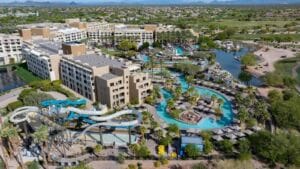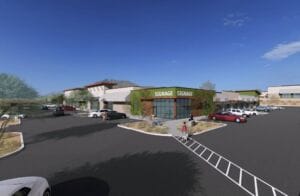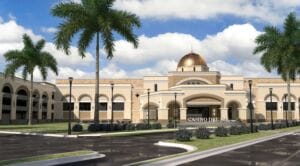For many, Phoenix malls conjure up memories of summer breaks as a youth with nowhere else better to be, convenient one-stop shopping trips for the whole family and the somewhat bewildering mix of smells radiating from the food court. Despite the warm feelings some associate with these locations, the omnipresence and convenience of ecommerce options has relegated many of these shopping centers to objects of nostalgia fondly remembered and reflected upon through rose-tinted glasses.
As a result of shifting consumer demand, the Valley has recently witnessed the shuttering of two iconic malls: Metrocenter Mall and Paradise Valley Mall. These sites are being reimagined as mixed-use developments focused on walkability and an urban village aesthetic.
READ ALSO: Metrocenter Mall is getting a $750 million makeover
RED Development announced on Feb. 15, 2022, that Paradise Valley Mall is being rechristened as PV — a more than 100-acre project that pays homage to its past while creating a new future for the property.
Phoenix City Councilwoman Deb Stark says, “It’s fantastic to see that through this evolution, from 1970s mall to world-class, mixed-use destination, developers RED and Macerich are committed to keeping the fabric of our community as the central focus that is inspiring the design, tenant mix and overall offering of PV.”
Phase one of PV will open in mid-2024 with a 400-unit luxury apartment building, Whole Foods Market, a new dine-in Harkins Theatre and three upscale, yet-to-be-announced restaurants. The initial phase will also include a three-acre central park and gathering place. The apartments will come in studio, one-, two- and three-bedroom configurations ranging from 504 to 1,760 square feet.
While the redeveloping of defunct Phoenix malls may seem novel, Sharon Harper, CEO and co-founder of Plaza Companies, notes that one must turn the calendar back nearly two decades to find the genesis of this trend.
“The real pioneer was Los Arcos Mall in 2003, which became SkySong,” she says. “That really was the turning point.”

Revolution for Metro Phoenix malls
Situated on 42 acres, SkySong is a mixed-use development that gives companies located there the opportunity to partner with Arizona State University (ASU) to gain access to — and collaborate with — researchers and faculty.
But before it became SkySong, the land was home to Los Arcos Mall — an indoor shopping center on Scottsdale and McDowell roads that Harper says saw the highest traffic counts throughout Greater Phoenix in the 1980s. Like the other malls that have met a similar fate, she says that during its heyday, Los Arcos offered lots of shops and stores in a vibrant community.
After it had deteriorated, there was a struggle about the future of the property. At one point, there were talks that the Coyotes might build a stadium in the mall’s place, but the team ended up in Glendale. Harper notes that the developer was frustrated and decided to build a Walmart instead.
“The neighbors got so upset about the idea. These malls are incredibly integrated with the people who live nearby — they were like the city center of the old days. Having a Walmart with a big parking lot didn’t have that sense of place and connection,” she says.
Around this time, Michael Crow had recently become president of ASU and had an idea for what he called a “technology innovation center” — something Harper says most people had little knowledge of.
“At the very beginning, our company was brought in as the master developer. Dr. Crow and ASU had studied innovation centers from around the globe, and we spent the first two weeks on the team in Ireland, Holland and Germany, looking at best practices of municipal, university and private development,” she recalls.
The integration of a public, private and university partnership was not widespread in the U.S., which is why the SkySong team traveled to Europe to see how existing technology innovation centers operated.
Community impact
“We returned with a great framework, but it was still a foreign idea,” Harper says. “Yet we came up with a design that brought the community back to the center. And with the right concept, a deteriorating mall had literally been transformational to a neighborhood, a region and now the state of Arizona. We started in 2003, so we were way ahead of these other malls, but it is proof of what good thinking, partnerships and staying the course can accomplish.”
To better understand the value of SkySong, local economist Elliot D. Pollack and Company was hired to examine the center’s economic significance. The Jan. 14, 2021, report called, “SkySong: A job creator with outsized ripple effects” on economic development in the region, with an estimated impact of $58.2 billion over the next 30 years. The innovation center generates approximately 9,350 jobs, $585.4 million in wages and $1.3 billion in economic activity annually.
“SkySong is an outlier,” the report states. “The project had many naysayers. Market conditions for commercial development in the early 2000s when SkySong was proposed were not optimal for the vast plan that came to fruition with the public-private- university partnership. In the end, the mutual vision of ASU, ASU Foundation, University Realty, Plaza Companies and the partnership with the City of Scottsdale overcame those limitations to develop a compact, modern, urban project at a site that private development would not have considered.”
Harper concludes that SkySong is on the list of every group looking for site selection in the Valley. “We have tours on a daily basis for mayors, legislators, university presidents and others from around our country asking, ‘How can we do something with a big sore spot in the middle of our town to generate wealth, jobs, increase property values and bring a sense of place and vibrancy back into a region?’ SkySong has become so well-known, it is now the national template for mall recreation.”




